March 2013
February 2013 Newsbytes archive
Posted by crossaffliction on Fri 1 Mar 2013 - 12:58Last month’s contributors include crossaffliction, dronon, earthfurst, Equivamp, Fred, GreenReaper, Higgs Raccoon, Kakurady, mwalimu, Rakuen Growlithe, RingtailedFox, Sonious and Vector.
No criminal charges over ambulance crash; driver not legally impaired, both vehicles were speeding
Posted by Patch Packrat on Fri 1 Mar 2013 - 13:18The loss of fursuiter Lemonade Coyote was met with widespread grief among members of furry fandom, including this remembrance from his friend Silver Wolf. Lemonade Coyote's coworker Cody Medley also sustained fatal injuries, after a car drove through an intersection and crashed into their ambulance while they were on the job as medics.
Police said the ambulance was not on an emergency run, but had the right of way when the car ran a flashing red light. An early report that "both medics were wearing seatbelts" is contradicted by a later report that neither wore seatbelts and both vehicles were speeding.
[Prosecutor Curry said] Hammer was driving 5 to 10 mph over the speed limit, while the ambulance was driving 15 to 20 mph over. The posted speed limit was 30 mph.
The driver whose traffic violation caused the crash had a blood alcohol level of 0.038, less than half the legal limit. According to the prosecutor, the traffic violation "does not rise to the level of criminal recklessness", and there will be no criminal charges for the fatal crash.
Review: 'The Singing Tree'/'The White Fox', by Brian Parvin
Posted by Fred on Sat 2 Mar 2013 - 04:52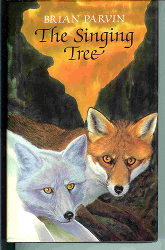
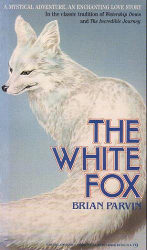 It is mostly forgotten today, but when The Singing Tree was published in England in the mid-Eighties, especially in its American paperback edition as The White Fox, early Furry fans told each other, “You’ve got to read this!” When the first Furry specialty publishers emerged at the end of the 1990s, some of the novel’s diehard fans urged that they try to bring out a new edition of The White Fox.
It is mostly forgotten today, but when The Singing Tree was published in England in the mid-Eighties, especially in its American paperback edition as The White Fox, early Furry fans told each other, “You’ve got to read this!” When the first Furry specialty publishers emerged at the end of the 1990s, some of the novel’s diehard fans urged that they try to bring out a new edition of The White Fox.
This was not bad for a novel that was unknown in most American public libraries and was only briefly available from an obscure American paperback publisher.
“The Singing Tree”, by Brian Parvin. Illustrated. London, Robert Hale, Ltd., March 1985, 185 pages, £8.95; ISBN: 0-7090-2159-3.
“The White Fox”, by Brian Parvin. Illustrated. Los Angeles, Medallion Books, July 1986, 238 pages, $3.50; ISBN: 1-55627-012-7.
'Doc Rat' cartoonist Jenner to draw 'Aus Doc' editorials
Posted by GreenReaper on Sat 2 Mar 2013 - 18:12 Part-time furry cartoonist and full-time MD Jenner, creator of UMA-nominated strip Doc Rat, has become an editorial cartoonist for Australian Doctor.
Part-time furry cartoonist and full-time MD Jenner, creator of UMA-nominated strip Doc Rat, has become an editorial cartoonist for Australian Doctor.
Jenner, better known in the medical world as Melbourne GP Dr. Craig Hilton, has been cartooning for over 25 years. Within the fandom, he is best known for the adventures of Dr. Benjamin Rat, which started June 2006.
The position at Aus Doc opened up after the retirement of Dr. Bob Futcher. [tip: Fred Patten]
Anthropomorphic Research Project launches 3-year study
Posted by GreenReaper on Sat 2 Mar 2013 - 20:09 The Anthropomorphic Research Project has released a new survey – the first in a series intended to cover the same people every February, June, and October over three years.
The Anthropomorphic Research Project has released a new survey – the first in a series intended to cover the same people every February, June, and October over three years.
Participants (who must be 18 or older) may enter a drawing to win a $50 Amazon.com certificate for each survey completed.
Questions will vary between each survey, but will generally pertain to different aspects of furry culture, sexual orientation, personality, well-being, recreational/fantasy activities, and attitudes/beliefs about topical issues (e.g. religion, politics).
The ARP has previously used surveys to distinguish furries from therians and otherkin, identify personality differences between non-furs, furries and their fursonas, and characterise the relationship between furries and bronies.
Furry Movie Award Watch: February 2013
Posted by crossaffliction on Sun 3 Mar 2013 - 00:26Well, I must say, I am enraged at the Oscars.
Host Seth MacFarlane promised at one point that the cast of Prometheus, my pick for worst movie of last year, would be up to explain “what the hell was going on there”. I watched the entire telecast, and was disappointed to find out that MacFarlane may have in fact have been joking. I was hoping they would just break down after attempting to explain it and start apologizing. No such luck.
I guess some other stuff happened too. Should probably write about that.
Animation: 'Müstiline raba'/'Mysterious Swamp', by Chintis Lundgren
Posted by Fred on Sun 3 Mar 2013 - 02:30Hmmm. I am not sure that I understand the 2’51” Müstiline Raba. Storks usually eat frogs, not the other way around. The Cartoon Brew says that this is “a delightful taste of that droll humor we’ve come to expect from Estonian animators.” Whatever. The fact that the stork wears a wristwatch and a frog plays a mandolin makes this anthropomorphic.
I have said previously that I do not understand Estonian animation. I still don’t.
For French-readers: Comics going back to 1901?
Posted by Fred on Sun 3 Mar 2013 - 15:05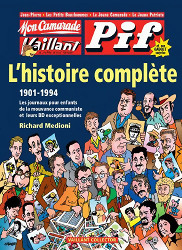 Well, not exactly. You are probably vaguely aware that there have been a lot of French-language funny-animal bandes dessinées going back decades. Chlorophylle the dormouse. Attila the dog. Billy the Cat. Gai-Luron the hound. Poussy. Inspector Canardo. Chaminou the cat. Jungle Fever. The Centaurs. (Are centaurs funny animals?) Yakari is a little North American Indian boy who meets lots of talking/magic animals. Pif the dog and Hercule the cat. The Schtroumpfs/Smurfs aren’t exactly funny animals, but they aren’t exactly humans, either. Not to mention many famous supporting characters: Tintin’s dog Snowy, Spirou’s squirrel Spip. The long-tailed marsupilami started out as a supporting character in the adventures of Spirou and Fantasio, eventually getting his own series.
Well, not exactly. You are probably vaguely aware that there have been a lot of French-language funny-animal bandes dessinées going back decades. Chlorophylle the dormouse. Attila the dog. Billy the Cat. Gai-Luron the hound. Poussy. Inspector Canardo. Chaminou the cat. Jungle Fever. The Centaurs. (Are centaurs funny animals?) Yakari is a little North American Indian boy who meets lots of talking/magic animals. Pif the dog and Hercule the cat. The Schtroumpfs/Smurfs aren’t exactly funny animals, but they aren’t exactly humans, either. Not to mention many famous supporting characters: Tintin’s dog Snowy, Spirou’s squirrel Spip. The long-tailed marsupilami started out as a supporting character in the adventures of Spirou and Fantasio, eventually getting his own series.
What you may not be aware of is that these characters did not appear in their own magazines. They were serialized, usually two pages at a time, in long-running weekly magazines, more like newspaper Sunday supplements in America; and then reprinted in their own albums. Spirou. Tintin. Pilote. Vaillant. Le Journal de Mickey.
Three comic book reviews: Pull List #8 (‘MLP:FiM’ and ‘TMNT’)
Posted by crossaffliction on Mon 4 Mar 2013 - 23:51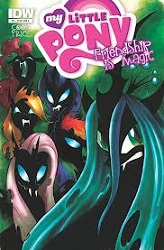 This issue, IDW sweeps the board, with My Little Pony: Friendship is Magic #3 and the first two installments of the latest Teenage Mutant Ninja Turtles mini-series, “The Secret History of the Foot Clan,” which tells the secret history of the Foot Clan. Turns out they were a parody of Marvel’s Hand ninjas all along!
This issue, IDW sweeps the board, with My Little Pony: Friendship is Magic #3 and the first two installments of the latest Teenage Mutant Ninja Turtles mini-series, “The Secret History of the Foot Clan,” which tells the secret history of the Foot Clan. Turns out they were a parody of Marvel’s Hand ninjas all along!
The A cover for this issue of My Little Pony: Friendship is Magic looks like a really, really rejected Marvel Secret Invastion crossover cover from a few years back. At least it gives you some kind of warning; heaven help you if you got the B cover, featuring Twilight Sparkle and Pinkie Pie happily ice skating. I may have juxtaposed Hack/Slash with this series last time, but I’m just kidding around. Apparently some like their ponies like their coffee; black and bitter.
Animation: 'Cloudy With a Chance of Meatballs 2'
Posted by Fred on Tue 5 Mar 2013 - 00:16When Flint [Lockwood] discovers that his [food-making] machine still operates and now creates mutant food beasts like living pickles, hungry tacodiles, shrimpanzees and apple pie-thons, he and his friends must return to save the world. [IMDb summary]
Let’s see … Anthro strawberry. Semi-anthro monkey. Anthro shrimpanzees. Anthro butter pats. Anthro sandwiches. Anthro giant taco supreme. Anthro celery. Anthro hamburgers. Anthro slice of cake. (And lots of humans.) Yep, Cloudy With a Chance of Meatballs 2: Revenge of the Leftovers, to be released from Columbia Pictures and Sony Pictures Animation on September 27, is an anthropomorphic animated feature.
Did anyone notice that the original children’s picture book, Cloudy With a Chance of Meatballs (1978) by Judi and Ron Barrett, has a completely different sequel, Pickles to Pittsburgh (2000)? Just in time for Anthrocon, presumably.
More coverage: ComingSoon.net - Yahoo Movies - Cartoon Brew
Furry sci-fi series 'Delura' starts Kickstarter campaign
Posted by Higgs Raccoon on Tue 5 Mar 2013 - 00:41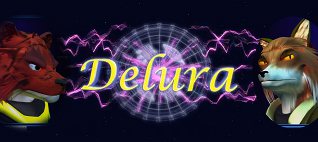 Delura is an independently-produced drama/space opera created by Ryan and Taben Roye of Tanadrine Studios. Started in 2010, the series is presented as a 3D webcomic and several animated shorts.
Delura is an independently-produced drama/space opera created by Ryan and Taben Roye of Tanadrine Studios. Started in 2010, the series is presented as a 3D webcomic and several animated shorts.
The titular Delura is the name of the galaxy in which the series takes place. The story includes many alien races resembling anthropomorphic animals, including vulpine and lupine beings. It centres on a felinoid mineship operator who finds himself with damaged memories in a strange medical ward, and reluctantly begins his new life whilst knowing nothing of who he was, is, or will be.
Ryan and Taben have started a Kickstarter campaign to fund Delura's 2013 season. A $6,500 goal has been set, to go towards providing more animations and webcomic content, and to upgrade hardware and software so as to improve the quality of the graphics.
A famous experiment in anthropomorphism and psychology
Posted by Patch Packrat on Tue 5 Mar 2013 - 18:23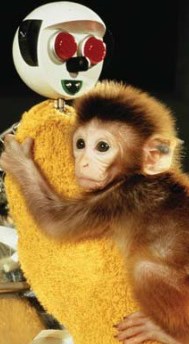 Sorry to interrupt fun stories about comics and cartoons, but the Anthropomorphic Research Project story suggests some want to know what furryness means. Let me throw in a topic sharing an abstract concept with the fandom.
Sorry to interrupt fun stories about comics and cartoons, but the Anthropomorphic Research Project story suggests some want to know what furryness means. Let me throw in a topic sharing an abstract concept with the fandom.
Anthropomorphism is often imagined from our human point of view (attaching human characteristics to something non-human). But the concept can exist apart from ourselves, when animals see themselves in objects. The way it works for them can reveal more about us.
Harry Harlow was a psychologist who experimented with monkeys. In the 1950's and 60's, he gave his subjects "surrogate" mothers built from different objects, to see how they would behave, and learn about care-giving and companionship in social and cognitive development. PBS says about his famous experiment:
He took infant monkeys away from their real mothers, giving them instead two artificial mothers, one model made of wire and the other made of cloth. The wire model was outfitted with a bottle to feed the baby monkey. But the babies rarely stayed with the wire model longer than it took to get the necessary food. They clearly preferred cuddling with the softer cloth model, especially if they were scared. (When the cloth model had the bottle, they didn't go to the wire model at all.)